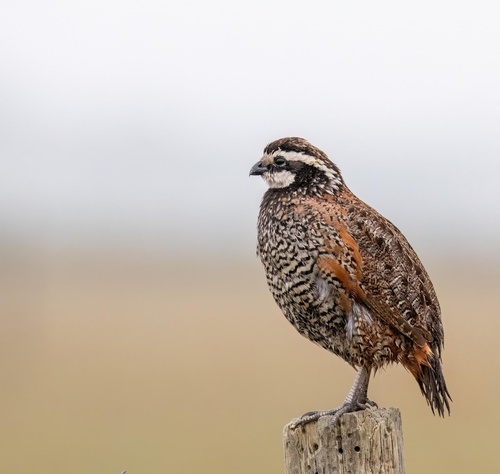
Northern Bobwhite
The Northern Bobwhite (*Colinus virginianus*) is a small, ground-dwelling bird known for its distinctive "bob-white" call. It plays a crucial role in its ecosystem as both a seed disperser and a prey species for larger predators. Historically, it was a very popular game bird, and while hunting continues, populations have declined significantly in many areas. Culturally, the Northern Bobwhite is often associated with rural landscapes and agricultural settings of the southeastern United States.
24-28 cm
Length
33-38 cm
Wingspan
Near Threatened
Conservation Status
Distribution
Native to North America, the Northern Bobwhite's range extends from southeastern Canada (primarily southern Ontario) and the eastern United States, south through Mexico and into parts of Central America, including Guatemala. Introduced populations exist in the Caribbean and other regions, but many have failed to establish.
Lifespan
Typically 1-2 years in the wild; can live up to 5 years in captivity. High mortality rates are common.
Northern Bobwhite's Habitat
Habitat Types
Grasslands, Savannas, Open woodlands, Agricultural fields, Early successional habitats
Climate Zones
Temperate, Subtropical, Tropical (in southern parts of its range)
Adaptations
Northern Bobwhites are well-adapted to ground-dwelling life. Their cryptic coloration provides camouflage in grassy environments. Strong legs and feet are suited for running and scratching for food. They prefer habitats with a mix of open areas for foraging and dense cover for nesting and protection.
Variations
Numerous subspecies (over 20) have been described, differing primarily in plumage coloration and geographic distribution. For example, the "Masked Bobwhite" (*C. v. ridgwayi*) is a critically endangered subspecies found in southern Arizona and Sonora, Mexico.
Appearance
Breeding Plumage
Males have a white throat and brow stripe bordered by black, while females have a buffy throat and brow stripe. Overall plumage is a mottled mix of brown, black, and white, providing excellent camouflage.
Seasonal Feather Changes
Minimal seasonal variation; molting occurs after the breeding season.
Sex Based Plumage Differences
Distinct differences in head markings (white in males, buff in females).
Notable Features
Short, rounded wings, Strong legs and feet, Cryptic, mottled plumage
Diet and Feeding
Primary Foods
Seeds, Insects, Leaves, Fruits, Grains
Foraging Behavior
Northern Bobwhites primarily forage on the ground, scratching and pecking at the soil to uncover seeds and insects. They often forage in small groups called coveys.
Specializations
Their strong legs and feet are well-suited for scratching the ground. They have a relatively short, stout beak adapted for picking up seeds.
Seasonal Diet Variations
Diet varies seasonally. Insects are a crucial food source for chicks and breeding adults during the spring and summer. Seeds and grains become more important in the fall and winter.
Behavior
Social Structure
Outside of the breeding season, Northern Bobwhites form coveys, which are family groups or groups of unrelated individuals. Coveys typically range from 2 to 20 birds. During the breeding season, coveys break up, and males become territorial.
Communication
The "bob-white" call, Soft whistles and clucking sounds, Visual displays (e.g., head bobbing, feather ruffling)
Migration
Northern Bobwhites are generally non-migratory, but they may make short-distance movements in response to severe weather or food shortages.
Territorial or Group Behaviors
Males defend territories during the breeding season. Coveys roost together in a circle, facing outwards, for warmth and protection.
Conservation
Threats
Habitat loss and fragmentation (due to agriculture, urbanization, and fire suppression), Pesticide use, Predation (by feral cats, raccoons, foxes, and other predators), Hunting pressure (in some areas)
Protection Programs
Conservation Reserve Program (CRP) in the US, Habitat restoration initiatives, Sustainable hunting management practices
Local National Laws
Protected under various state and federal laws in the US and Canada. Hunting regulations vary by state/province.
Population Trend
Decreasing
Population Estimates
Global population estimated at around 5.8 million, but declining significantly in many areas.
Interesting Facts
They are highly prolific breeders.
A single female can lay multiple clutches of eggs in a single breeding season if conditions are favorable.
Coveys roost in a circle.
This behavior helps conserve heat and provides 360-degree vigilance against predators.
They are sometimes called "partridges" in the southern US.
Although they are not true partridges (which are in the family Phasianidae).
Faqs about Northern Bobwhite
What do I do if I find a baby Northern Bobwhite?
If the chick appears healthy and is in a safe location, it's best to leave it alone. The parents are likely nearby. If it is injured or in immediate danger, contact a local wildlife rehabilitator. *Consult a professional for medical or expert advice.*
Are Northern Bobwhites good to eat?
Yes, they are a popular game bird and are considered to have a delicate flavor.
Why are Northern Bobwhite populations declining?
The primary reason is habitat loss and fragmentation due to changes in land use practices. The decline of early successional habitats, which they rely on, is a major factor.
Copyright @ Nature Style Limited. All Rights Reserved.
 English
English